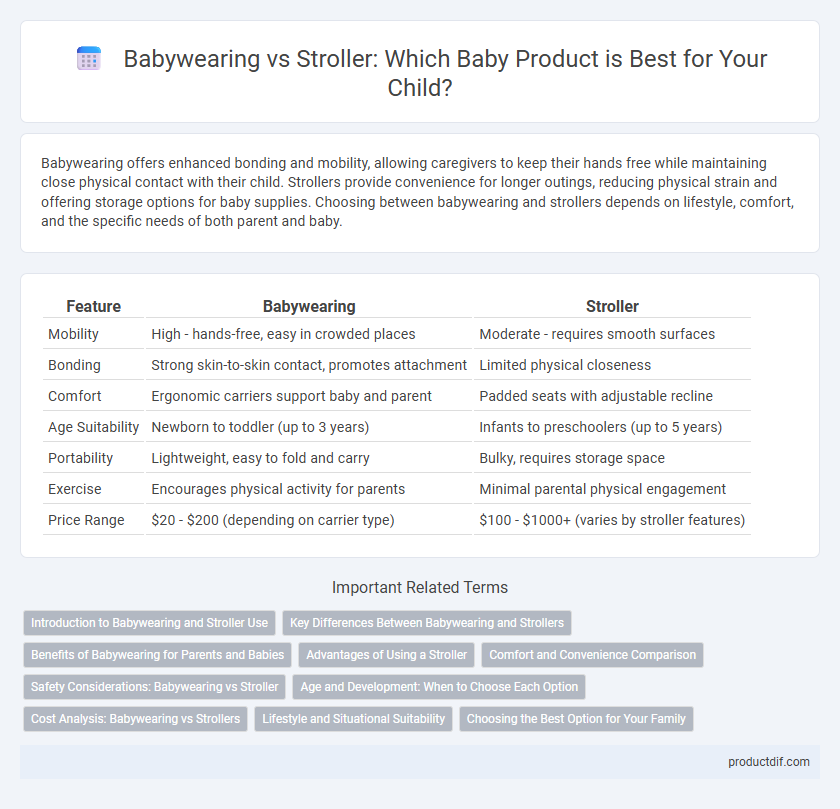Babywearing offers enhanced bonding and mobility, allowing caregivers to keep their hands free while maintaining close physical contact with their child. Strollers provide convenience for longer outings, reducing physical strain and offering storage options for baby supplies. Choosing between babywearing and strollers depends on lifestyle, comfort, and the specific needs of both parent and baby.
Table of Comparison
| Feature | Babywearing | Stroller |
|---|---|---|
| Mobility | High - hands-free, easy in crowded places | Moderate - requires smooth surfaces |
| Bonding | Strong skin-to-skin contact, promotes attachment | Limited physical closeness |
| Comfort | Ergonomic carriers support baby and parent | Padded seats with adjustable recline |
| Age Suitability | Newborn to toddler (up to 3 years) | Infants to preschoolers (up to 5 years) |
| Portability | Lightweight, easy to fold and carry | Bulky, requires storage space |
| Exercise | Encourages physical activity for parents | Minimal parental physical engagement |
| Price Range | $20 - $200 (depending on carrier type) | $100 - $1000+ (varies by stroller features) |
Introduction to Babywearing and Stroller Use
Babywearing promotes closeness and bonding by securing the infant against the caregiver's body, enhancing physical development and emotional security through constant contact. Strollers offer convenience and mobility for longer distances or crowded spaces, providing comfort with features like adjustable seats and storage compartments. Choosing between babywearing and strollers depends on lifestyle needs, safety considerations, and ease of use during outdoor activities or daily errands.
Key Differences Between Babywearing and Strollers
Babywearing offers enhanced bonding and hands-free mobility, promoting closeness and easy navigation in crowded spaces, while strollers provide convenient storage and comfort for longer outings. Baby carriers support ergonomic positioning, reducing strain on the caregiver's back, whereas strollers accommodate infants from newborn to toddler stages with adjustable seating and suspension. Both options prioritize infant safety, but babywearing encourages physical contact essential for infant development, contrasting with strollers' emphasis on practical transportation.
Benefits of Babywearing for Parents and Babies
Babywearing promotes stronger parent-child bonding through close physical contact, enhancing emotional security and attachment in infants. It supports healthy infant development by maintaining proper hip positioning and allows parents hands-free mobility, increasing convenience during daily activities. This practice also helps regulate the baby's temperature and heart rate, reducing crying and promoting better sleep patterns.
Advantages of Using a Stroller
Strollers provide ergonomic support and comfort for babies during long outings, reducing strain on the child's developing spine. They offer ample storage space for baby essentials, enhancing convenience for caregivers. Using a stroller also allows greater mobility over diverse terrains, making it ideal for outdoor activities and urban environments.
Comfort and Convenience Comparison
Babywearing offers superior comfort through close physical contact, which soothes infants and promotes bonding, while freeing parents' hands for multitasking. Strollers provide convenience for longer distances and carrying heavier loads but can be cumbersome in crowded or uneven terrain. Choosing between babywearing and strollers depends on the need for mobility, comfort, and the specific activities planned.
Safety Considerations: Babywearing vs Stroller
Babywearing allows for close physical contact, promoting infant security and emotional bonding while keeping the baby's airway clear when used correctly; however, it requires proper positioning to prevent risks like suffocation or hip dysplasia. Strollers offer structured safety features such as harness systems, padded seats, and stability on various terrains, but they may expose infants to environmental hazards and require attentive supervision to avoid accidents. Choosing between babywearing and strollers depends on factors like the baby's age, caregiver's mobility, and situational safety requirements, emphasizing that both methods must adhere to strict safety guidelines to ensure infant protection.
Age and Development: When to Choose Each Option
Newborns and infants up to 6 months benefit most from babywearing due to the need for close physical contact that supports brain development and emotional bonding. Strollers become more suitable around 6 months to 3 years, as babies gain better head and neck control and enjoy longer outdoor excursions. For toddlers, strollers offer comfort during extended outings while babywearing remains ideal for quick errands and promoting independence during early walking stages.
Cost Analysis: Babywearing vs Strollers
Babywearing offers a cost-effective alternative to strollers, with affordable wraps and carriers typically ranging from $20 to $100, compared to strollers that can cost anywhere from $150 to over $1,000 depending on features and brand. Maintenance expenses for strollers, such as repairs and replacement parts, can add up over time, while baby carriers require minimal upkeep. Choosing babywearing not only reduces initial investment but also lowers ongoing costs, making it a budget-friendly option for families.
Lifestyle and Situational Suitability
Babywearing offers hands-free mobility and close physical contact, ideal for parents who navigate crowded places or engage in multitasking daily. Strollers provide comfort and convenience for longer distances or uneven terrains, making them suitable for outdoor walks and urban outings. Choosing between babywearing and strollers depends on lifestyle needs, such as activity level and environmental context.
Choosing the Best Option for Your Family
Babywearing offers close physical bonding and hands-free mobility, promoting emotional connection and easier navigation in crowded spaces. Strollers provide convenience for longer outings, carrying capacity for essentials, and comfort for both baby and caregiver during extended walks. Families should assess lifestyle, activity level, and baby's age to determine the best choice between baby carriers and strollers for daily use.
Babywearing vs Stroller Infographic

 productdif.com
productdif.com